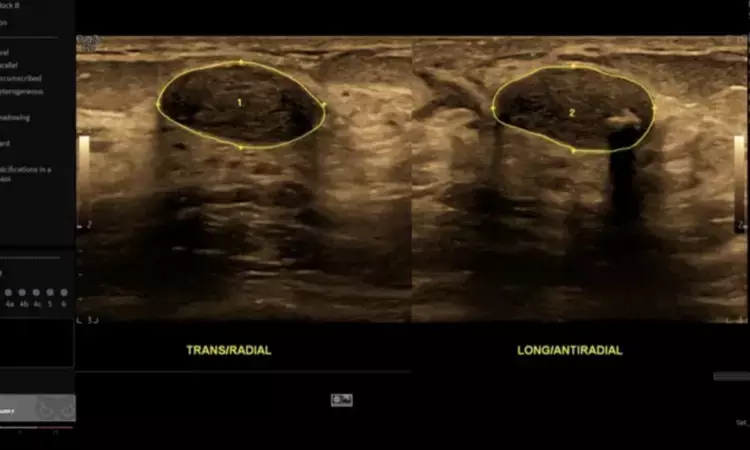- Home
- Medical news & Guidelines
- Anesthesiology
- Cardiology and CTVS
- Critical Care
- Dentistry
- Dermatology
- Diabetes and Endocrinology
- ENT
- Gastroenterology
- Medicine
- Nephrology
- Neurology
- Obstretics-Gynaecology
- Oncology
- Ophthalmology
- Orthopaedics
- Pediatrics-Neonatology
- Psychiatry
- Pulmonology
- Radiology
- Surgery
- Urology
- Laboratory Medicine
- Diet
- Nursing
- Paramedical
- Physiotherapy
- Health news
- Fact Check
- Bone Health Fact Check
- Brain Health Fact Check
- Cancer Related Fact Check
- Child Care Fact Check
- Dental and oral health fact check
- Diabetes and metabolic health fact check
- Diet and Nutrition Fact Check
- Eye and ENT Care Fact Check
- Fitness fact check
- Gut health fact check
- Heart health fact check
- Kidney health fact check
- Medical education fact check
- Men's health fact check
- Respiratory fact check
- Skin and hair care fact check
- Vaccine and Immunization fact check
- Women's health fact check
- AYUSH
- State News
- Andaman and Nicobar Islands
- Andhra Pradesh
- Arunachal Pradesh
- Assam
- Bihar
- Chandigarh
- Chattisgarh
- Dadra and Nagar Haveli
- Daman and Diu
- Delhi
- Goa
- Gujarat
- Haryana
- Himachal Pradesh
- Jammu & Kashmir
- Jharkhand
- Karnataka
- Kerala
- Ladakh
- Lakshadweep
- Madhya Pradesh
- Maharashtra
- Manipur
- Meghalaya
- Mizoram
- Nagaland
- Odisha
- Puducherry
- Punjab
- Rajasthan
- Sikkim
- Tamil Nadu
- Telangana
- Tripura
- Uttar Pradesh
- Uttrakhand
- West Bengal
- Medical Education
- Industry
Artificial Intelligence Aids Radiologist to classify Masses in Breast Ultrasound

Courtesy by Koiosmedical
Artificial intelligence (AI) is gaining extensive attention for its excellent performance in image-recognition tasks and increasingly applied in breast ultrasound. In a recent study presented at the annual meeting of the American Roentgen Ray Society (ARRS), researchers have reported that artificial intelligence (AI) helps to characterize masses found on ultrasound by improving cancer detection and reducing false positives.
"AI software appears to be a complementary tool for radiologists," Philpotts said during a presentation at the recent annual meeting of the American Roentgen Ray Society (ARRS).
Incidental solid masses are commonly found on whole breast screening ultrasound (WBUS). However, the management of incidental solid masses found during these examinations is not well established. A research team led by Dr Liane Philpotts conducted a study to retrospectively evaluate the impact of an FDA approved decision support software on BI-RADS 3 and BI-RADS 4 classified lesions detected on screening breast ultrasound.
The researchers retrospectively analysed the breast imaging electronic database (PenRad Inc, MN) over one year to identify lesions reported as BR3 and BR4 on WBUS following a normal digital breast tomosynthesis mammogram.
They included a total of 206 lesions of BI-RADS 3 or higher from 206 patients in this analysis. Among 206 lesions, 162 were diagnosed as BI-RADS 3 (probably benign) by the radiologist and, 44 were deemed to be BI-RADS 4 (suspicious). There were seven malignant lesions, two of which were classified by the original interpreting radiologist as BI-RADS 3 and five of which were categorized as BI-RADS 4. The remaining 109 lesions were benign. They analyzed the lesions using proprietary artificial intelligence (AI) software platform (Koios DS). The software analyzes orthogonal B-mode images and classifies them according to risk. They further evaluated the system against pathological or a minimum of 6-month stable follow-up ground truth. Shifts from BI-RADS 3 and BI-RADS 4 assessments (assigned by dedicated breast radiologists) into BI-RADS 2, 3 and 4 were then evaluated, along with an overall ROC Curve AUC and sensitivity computed between initial radiologist reads and the system.
Key findings of the study were:
- Upon analysis, the researchers found that the AI software would have downgraded 41% to BI-RADS 2 and upgraded 32% to BI-RADS 4.
- Using the software, the researchers identified all malignant lesions, including the two lesions originally categorized as BI-RADS 3 by the initial interpreting radiologist.
- They noted that the overall system sensitivity was 100% and, radiologist sensitivity was 71.4%.
The authors concluded, "Utilization of an AI decision support tool for WBUS findings could result in shifts in the final BI-RADS categories with the potential to increase the per cent of lesions characterized as benign and increase sensitivity for malignant lesions. Larger and prospective studies in how the tool integrates into the workflow and influences management will be needed."
For further information:
ARRS 2021 Abstract
Medical Dialogues Bureau consists of a team of passionate medical/scientific writers, led by doctors and healthcare researchers. Our team efforts to bring you updated and timely news about the important happenings of the medical and healthcare sector. Our editorial team can be reached at editorial@medicaldialogues.in.
Dr Kamal Kant Kohli-MBBS, DTCD- a chest specialist with more than 30 years of practice and a flair for writing clinical articles, Dr Kamal Kant Kohli joined Medical Dialogues as a Chief Editor of Medical News. Besides writing articles, as an editor, he proofreads and verifies all the medical content published on Medical Dialogues including those coming from journals, studies,medical conferences,guidelines etc. Email: drkohli@medicaldialogues.in. Contact no. 011-43720751


